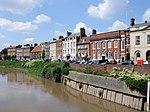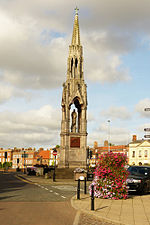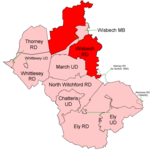Wisbech Castle was a stone to motte-and-bailey castle built to fortify Wisbech (historically in the Isle of Ely and now also in the Fenland District of Cambridgeshire, England) on the orders of William I in 1072, it probably replaced an earlier timber and turf complex. The layout was probably oval in shape and size, on the line still marked by the Circus. The original design and layout is unknown.
It was rebuilt in stone in 1087.
The castle was reputedly destroyed in a flood in 1236.
In the 15th century, repairs were becoming too much for the ageing structure, and a new building was started in 1478 under John Morton, Bishop of Ely (later Archbishop of Canterbury and Chancellor of England). His successor, John Alcock, extended and completed the re-building and died in the Castle in 1500. Subsequent bishops also spent considerable sums on this new palace. The Bishop's Palace was built of brick with dressings of Ketton Stone, but its exact location is unknown.
In later Tudor times, the rebuilt castle became a notorious prison. The site was again redeveloped in the mid-17th century and yet again in 1816 by Joseph Medworth. A 1794 plan of the 'castle' exists; this only shows the 'castle' as it existed at the end of the 18th century, prior to the development of the site to its current form.
The Regency building known as The Castle, Museum Square, Wisbech PE13 3ES was given Grade II* listed status on 31 October 1983 following the vaults Grade II listed in 1969. It now stands in the middle of a circus.










